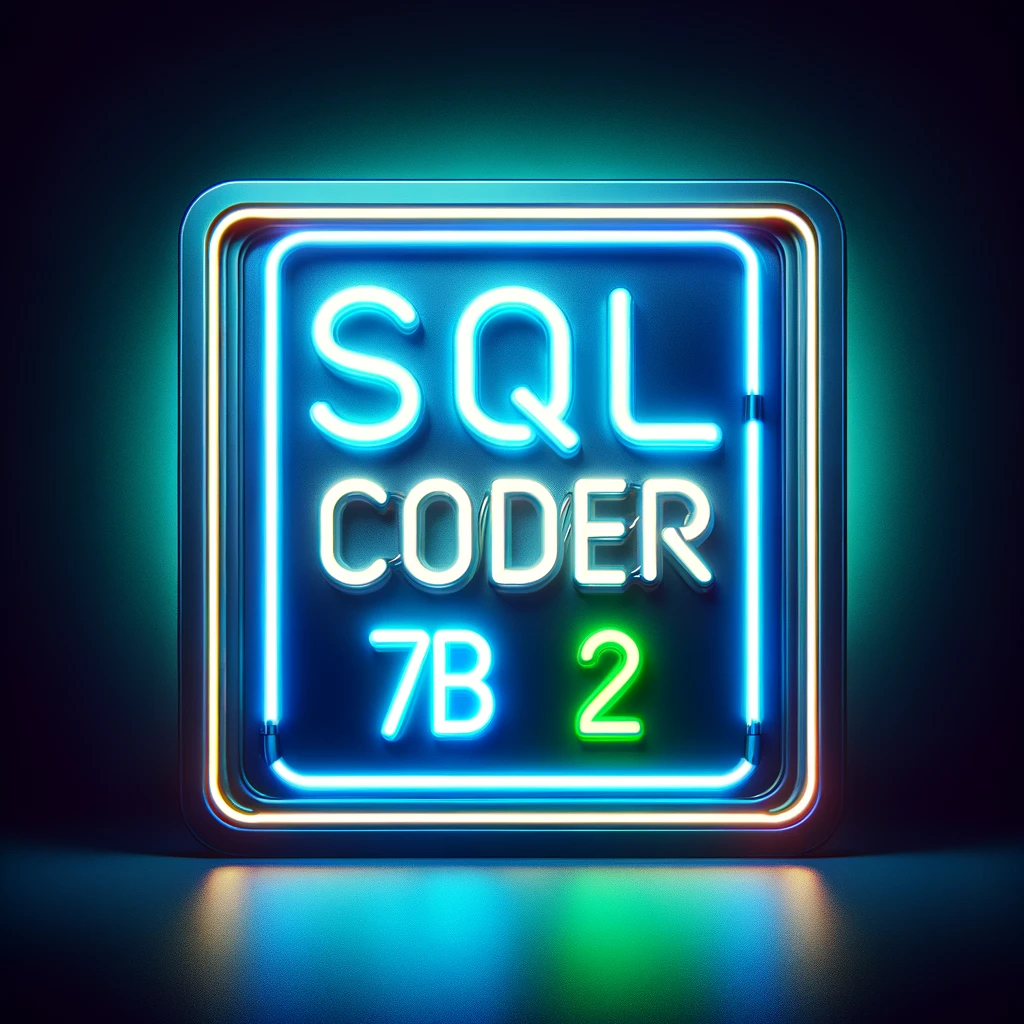defog-sqlcoder-q8
Maintainer: gregwdata

12

| Property | Value |
|---|---|
| Run this model | Run on Replicate |
| API spec | View on Replicate |
| Github link | View on Github |
| Paper link | No paper link provided |
Create account to get full access
Model overview
defog-sqlcoder-q8 is a capable large language model created by gregwdata for converting natural language questions into SQL queries. It is a 15B parameter model fine-tuned on a base StarCoder model.
Similar models include defog-sqlcoder-7b-2, a 7B parameter model that outperforms GPT-3.5-Turbo on natural language to SQL generation tasks, and sqlcoder2, a 15B parameter model that can outperform GPT-4 on certain SQL-related benchmarks when fine-tuned on a specific schema.
Model inputs and outputs
defog-sqlcoder-q8 takes in a natural language question and a description of the database schema, and generates SQL code to answer the question. The model can handle a wide variety of SQL query types, from simple SELECT statements to complex queries involving joins, aggregations, and subqueries.
Inputs
- Prompt: The natural language question to be converted to SQL
- Schema Metadata: A description of the database schema, including the tables, columns, and relationships
- Seed: An optional seed value for reproducible outputs
- Debug: A flag to enable debug output
Outputs
- SQL Query: The generated SQL query that attempts to answer the input question
Capabilities
defog-sqlcoder-q8 is capable of converting a wide range of natural language questions into complex SQL queries. It can handle queries involving table joins, aggregations, calculations, and other advanced SQL concepts. The model has been evaluated on a benchmark dataset and is shown to outperform GPT-3.5-Turbo and other popular open-source models.
What can I use it for?
defog-sqlcoder-q8 can be used to build applications that allow users to interact with databases using natural language. This could include things like business intelligence tools, data exploration platforms, or even chatbots that can answer questions about data. The model could also be fine-tuned on a specific domain or data schema to further improve its performance.
Things to try
One interesting thing to try with defog-sqlcoder-q8 is to provide it with a complex natural language question and see how it breaks down the problem and generates the SQL query. Pay attention to how the model uses table aliases and handles different SQL constructs to answer the question accurately. You could also try providing the model with a variety of database schemas and see how its performance varies across different domains.
This summary was produced with help from an AI and may contain inaccuracies - check out the links to read the original source documents!
Related Models

defog-sqlcoder-7b-2

21
The defog-sqlcoder-7b-2 is a capable large language model for natural language to SQL generation, developed by the maintainer nateraw. It can be compared to similar models like snowflake-arctic-instruct, an efficient and intelligent open-source language model, and meta-llama-3-8b-instruct, an 8 billion parameter language model from Meta fine-tuned for chat completions. Model inputs and outputs The defog-sqlcoder-7b-2 model takes in a variety of inputs, including a question, table metadata, and optional parameters like temperature, top-k filtering, and presence/frequency penalties. The model then generates a SQL query as output to answer the given question based on the provided database schema. Inputs Question**: The natural language question to be answered Table Metadata**: A description of the database schema the query will run on Temperature**: A value used to modulate the next token probabilities Max New Tokens**: The maximum number of tokens the model should generate Top K**: The number of highest probability tokens to consider for generating the output Top P**: A probability threshold for generating the output Presence Penalty**: Encourages the model to talk about new topics Frequency Penalty**: Discourages the model from repeating the same tokens Outputs SQL Query**: The generated SQL query to answer the given question Capabilities The defog-sqlcoder-7b-2 model is capable of generating SQL queries to answer natural language questions based on a provided database schema. It can handle a variety of query types and can be fine-tuned on specific domains or datasets. What can I use it for? The defog-sqlcoder-7b-2 model can be used in a variety of applications that involve translating natural language to SQL, such as building user-friendly database interfaces, automating data analysis tasks, or powering natural language-based data exploration tools. Companies could potentially monetize this model by integrating it into their products or services to provide more accessible data querying capabilities for their customers. Things to try One interesting thing to try with the defog-sqlcoder-7b-2 model is to experiment with the various input parameters, such as adjusting the temperature or top-k/top-p values, to see how it affects the generated SQL queries. You could also try fine-tuning the model on a specific database schema or domain to see if it improves the model's performance on that task.
Updated Invalid Date
🤷
sqlcoder

299
sqlcoder is a state-of-the-art large language model developed by Defog for converting natural language questions to SQL queries. It slightly outperforms the popular gpt-3.5-turbo model on natural language to SQL generation tasks, and significantly outperforms all other popular open-source models like text-davinci-003 and wizardcoder. The model was fine-tuned on a base StarCoder model. Model inputs and outputs The sqlcoder model takes in natural language questions as input and generates SQL queries as output. The model was trained on a diverse dataset of over 10,000 human-curated questions spanning 10 different database schemas. Inputs Natural language questions about querying databases Outputs SQL queries that correspond to the input natural language questions Capabilities The sqlcoder model demonstrates strong performance on a variety of SQL query types, including where, group by, order by, ratio, join, and more. It significantly outperforms other models like gpt-3.5-turbo and text-davinci-003 on these tasks. What can I use it for? The sqlcoder model is well-suited for building analytics tools that allow non-technical users to easily explore and understand data stored in SQL databases. By translating natural language questions into SQL, the model empowers users to quickly get insights without needing SQL expertise. Things to try One interesting aspect of sqlcoder is its ability to handle increasingly complex SQL queries as the training data difficulty increases. The model's performance jumps by 7 percentage points when fine-tuned on the "hard" and "extra hard" questions in addition to the "easy" and "medium" ones. This suggests the model could potentially be further improved by continued fine-tuning on more challenging data.
Updated Invalid Date
🌿
sqlcoder2

105
sqlcoder2 is a state-of-the-art language model developed by Defog for converting natural language questions to SQL queries. It outperforms popular models like gpt-3.5-turbo and text-davinci-003 on benchmark tasks, and can significantly outperform gpt-4 when fine-tuned on a given database schema. The model is built on top of a base StarCoder model and has been fine-tuned on over 20,000 human-curated SQL questions covering 10 different database schemas. Notably, the training data did not include any of the schemas used in the evaluation framework, allowing for testing on truly novel datasets. Model inputs and outputs Inputs Natural language questions**: The model takes natural language questions about data stored in a database as input. Database schema information**: The model also accepts information about the database schema that the SQL query will run against, such as table and column definitions. Outputs SQL queries**: The model outputs SQL queries that aim to answer the input natural language question based on the provided database schema. Capabilities sqlcoder2 demonstrates strong performance on a variety of SQL-related tasks, including date filtering, group-by and aggregation, order-by, ratio calculations, table joins, and where clause filtering. It is particularly adept at more complex queries involving multiple steps and operations. What can I use it for? sqlcoder2 can be a valuable tool for non-technical users who need to interact with and analyze data stored in SQL databases. By allowing them to ask questions in natural language and generating the corresponding SQL, it enables self-service analytics without requiring SQL expertise. Some potential use cases include: Powering a conversational analytics interface for business users Automating the generation of SQL reports and dashboards Enabling data exploration and discovery for data scientists and analysts Things to try One interesting aspect of sqlcoder2 is its ability to outperform even large language models like gpt-4 when fine-tuned on a specific database schema. This suggests that targeted fine-tuning on relevant data can significantly boost the model's performance for domain-specific tasks. Developers could explore fine-tuning sqlcoder2 on their own database schemas to unlock its full potential within their organization's data infrastructure.
Updated Invalid Date
💬
sqlcoder-7b

59
sqlcoder-7b is a 7 billion parameter model developed by Defog that is designed for converting natural language questions into SQL queries. It is a state-of-the-art language model that outperforms popular open-source models like GPT-3.5 and even GPT-4 on natural language to SQL generation tasks. The model is fine-tuned on a base Mistral-7B model. Compared to similar models like sqlcoder2 and sqlcoder-34b-alpha, sqlcoder-7b has slightly lower performance but consumes fewer GPU resources, making it more accessible for users with less powerful hardware. The maintainer, Defog, has also developed larger models like sqlcoder2 and sqlcoder-34b-alpha that offer even better performance. Model inputs and outputs Inputs Natural language question**: The model takes as input a natural language question about data stored in a database. Outputs SQL query**: The model outputs a SQL query that can be used to retrieve the data to answer the input question. Capabilities sqlcoder-7b is highly capable at translating natural language questions into accurate SQL queries. It performs particularly well on questions involving group-by, order-by, and date-based operations, outperforming GPT-4 and other popular models. The model also handles complex queries involving joins and ratio calculations effectively. What can I use it for? You can use sqlcoder-7b as an analytics tool to empower non-technical users to explore data stored in SQL databases. By allowing users to ask questions in plain language and generating the corresponding SQL queries, the model can make data more accessible and enable faster insights. This model could be particularly useful for customer-facing applications, business intelligence tools, or data exploration platforms where end-users need to query data without writing SQL directly. Things to try Try providing the model with a variety of natural language questions covering different database schema and query types. Observe how the model performs on complex queries involving aggregations, joins, and advanced SQL constructs. You can also experiment with fine-tuning the model on your own dataset to improve its performance on your specific use case.
Updated Invalid Date